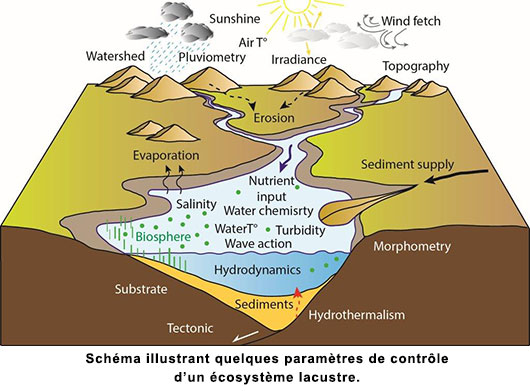ThESIS BY Alexandre Lettéron*
Deciphering environmental changes and their impacts on ecosystems is one of the major challenges facing our modern societies. In this respect, due to fluctuations in their level and very rapid ecological variationsa, lacustrine sedimentary systems constitute particularly comprehensive and accurate records of the evolution of environmental parameters (figure) over geological timescales.
However, a problem concerns the identification and ranking of these parameters in terms of impact, in order to build predictive models. These models will be used to quantify the evolution of lacustrine systems, in terms of water hydrology, ecology and geochemistry (salinity, alkalinity, etc.).
The thesis focused on combining — something that is rarely done — sedimentological, palaeontological, palaeobotanical and geochemical approaches for the characterization of lacustrine sedimentary series(1), dating back to the Priabonian era, in South-East France. This was a key period in the history of the Earth, heralding the start of the EOTb: the last major climate crisis of the past 50 million years.

for a lacustrine system.
This research demonstrated the impact of the pre-crisis climatic instability on the ecosystem(2). Its results provide some of the keys to understanding and modeling environmental problems such as the eutrophicationc and salinization of continental water bodies. They will be incorporated into ongoing reflection processes at IFPEN in order to refine stratigraphic modeling and adapt them to current environmental problems.
a - Due to their generally closed character and their small size with, among other things, water that is highly variable chemically.
b - Eocene-Oligocene Transition (or “Grande coupure”, i.e., “Great Break”).
c - Excessive accumulation of nutrients (P, N, K) in the aquatic system.
*Thesis entitled "Sedimentological, stratigraphic and paleoenvironmental characterization of the variable salinity lacustrine carbonate system of the Alès Basin and bordering regions (Priabonian, S-E France): paleoclimatic and paleogeographic implications"
(1) A. Lettéron, F. Fournier, Y. Hamon, L. Villier, J-P. Margerel, A. Bouche, M. Feist, P. Joseph, Multi-proxy paleoenvironmental reconstruction of saline lake carbonates: Paleoclimatic and paleogeographic implications (Priabonian-Rupelian, Issirac Basin, SE France), 2017. Sedimentary Geology, Vol. 358, pp. 97−120.
>> DOI: 10.1016/j.sedgeo.2017.07.006
(2) A. Lettéron, Y. Hamon, F. Fournier, M. Séranne, P. Pellenard, P. Joseph, Reconstruction of a saline, lacustrine carbonate system (Priabonian, St-Chaptes Basin, SE France): Depositional models, paleogeographic and paleoclimatic implications, 2018. Sedimentary geology, Vol. 367, pp. 20-47.
>> DOI: 10.1016/j.sedgeo.2017.12.023
Scientific contact: youri.hamon@ifpen.fr





